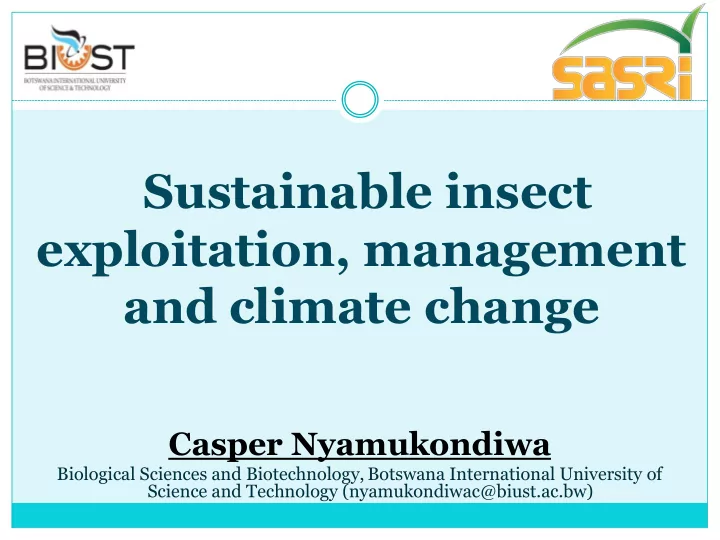

Sustainable insect exploitation, management and climate change Casper Nyamukondiwa Biological Sciences and Biotechnology, Botswana International University of Science and Technology (nyamukondiwac@biust.ac.bw)
Climate is changing
Changes in biogeography pattern
Temperature (°C) 10 15 20 25 30 35 -5 0 5 Heat and cold snaps A
Implications of global change • Short generation times More generations per year • • Increased T ° C and DD accumulation Reduced overwintering- more pest pressure • • Asynchrony between host-natural enemy Reduced efficacy of biological control •
Implications of global change • Creation of new structures in native pest abundance Emergence of 2° to 1° insect pests • • Decreased food and nutrition security • Modification of habitats Pest colonization of new previously unfavorable • habitats Loss of natural enemy biological diversity/ lack of • fitness/efficacy Loss of ecosystem function • Consequence on pest management/food security •
Loss coevolved basal and plastic responses to temperature may underlie trophic level host- parasitoid interactions under climate change • (1) High temperature tolerance • Plutella xylostella vs Cotesia vestalis 49 6.0 0.5 °C/min b a 0.25 °C/min 48 ab ab Heat knockdown time (minutes) 0.12 °C/min b 5.5 47 Critical Thermal Maxima (°C) bc c 46 d d 5.0 45 44 4.5 43 a 42 a 4.0 41 40 e 3.5 39 38 3.0 37 C. vestalis adult P. xylostella larvae P. xylostella adult C. vestalis adult P. xylostella larvae P. xylostella adult Treatment Treatment
Low temperature tolerance 4.0 3 0.5 °C/min b Chill comma recovery time (minutes) a a 0.25 °C/min 3.8 2 0.12 °C/min a Critical Thermal Minima (°C) 3.6 1 3.4 a 0 3.2 -1 3.0 b b a bc -2 2.8 c cd -3 2.6 d -4 2.4 2.2 -5 2.0 -6 C. vestalis adult P. xylostella larvae P. xylostella adult C. vestalis adult P. xylostella larvae P. xylostella adult Treatment Treatment
High/low temperature tolerance 120 120 C. vestalis adult P. xylostella larvae P.xylostella adult 100 100 80 80 Survival (%) Survival (%) 60 60 40 40 20 20 0 0 -20 -20 -20 -18 -16 -12 -8 -6 -2 0 2 31 34 36 38 40 42 44 46 Temperature (°C) Temperature (°C)
Thermal tolerance traits vs prevailing microclimates Px a Px l Temperature (°C) Cv 50 40 Results show Temperature (°C) 30 thermal 20 divergence on an 10 economically important host- 0 parasitoid system -10 5 5 5 5 6 6 6 6 1 1 1 1 1 1 1 1 0 0 0 0 0 0 0 0 2 2 2 2 2 2 2 2 / / / / / / / / 1 1 1 1 1 1 1 1 1 1 1 1 1 1 1 1 / / / / / / / / 5 7 9 1 1 3 5 7 1 Dates
Thermal resilience may shape population abundance of two sympatric congeneric species (Hymenoptera: Braconidae) • Cotesia flavipes & Cotesia sesamiae A B 100 100 0.5 hr 0.5 hr 1 hr 80 80 1 hr 2 hr 2 hr 4 hr Survival (%) Survival (%) 4 hr 60 60 40 40 20 20 0 0 -15 -13 -11 -9 -7 -5 -3 -1 0 1 3 4 5 -15 -13 -11 -9 -7 -5 -3 -1 0 1 3 4 5 Temperature ( o C) Temperature ( o C) Cotesia sesamiae Cotesia flavipes
Thermal resilience may shape population abundance of two sympatric congeneric species (Hymenoptera: Braconidae) C D 100 100 80 80 Survival (%) Survival (%) 0.5 hr 0.5 hr 60 60 1 hr 1 hr 2 hr 2 hr 4 hr 4 hr 40 40 20 20 0 0 35 37 38 39 40 42 44 35 36 37 38 39 41 42 44 Temperature ( o C) Temperature ( o C) Cotesia flavipes Cotesia sesamiae
High temperature tolerance 46 30 b b B Heat knock-down time (minutes) 45 28 Critical thermal maxima ( o C) 44 26 43 24 42 a a 41 22 40 20 39 18 38 37 16 Cotesia sesam iae Cotesia flavipes Cotesia sesamiae Cotesia flavipes Species Species
Low temperature tolerance 3.0 5.5 a a A Chill coma recovery time (minutes) 2.8 5.0 2.6 Critical thermal minima ( o C) 2.4 4.5 2.2 b b 2.0 4.0 1.8 1.6 3.5 1.4 1.2 3.0 1.0 0.8 2.5 0.6 0.4 2.0 Cotesia sesam iae Cotesia flavipes Cotesia sesamiae Cotesia flavipes Species Species
Way forward Use of evolutionary physiology? • Phenotypic plasticity (=thermal preconditioning) • As a method of improving insect mass rearing techniques • For improvement of biocontrol programs. • Through evolutionary resilience 35 A Take T° C in ‘bug’ factory 30 25 Temperature (°C) 20 Against T°C in natural habitat 15 10 And consequences of fitness 5 and efficacy of mass reared 0 natural enemies for biocontrol?? -5
Detailed reading
Acknowledgements
Recommend
More recommend